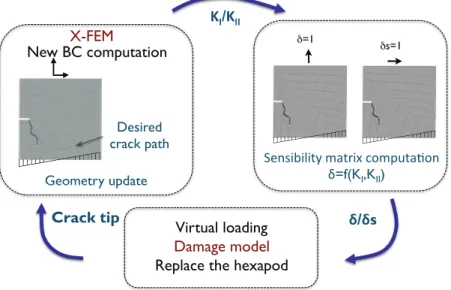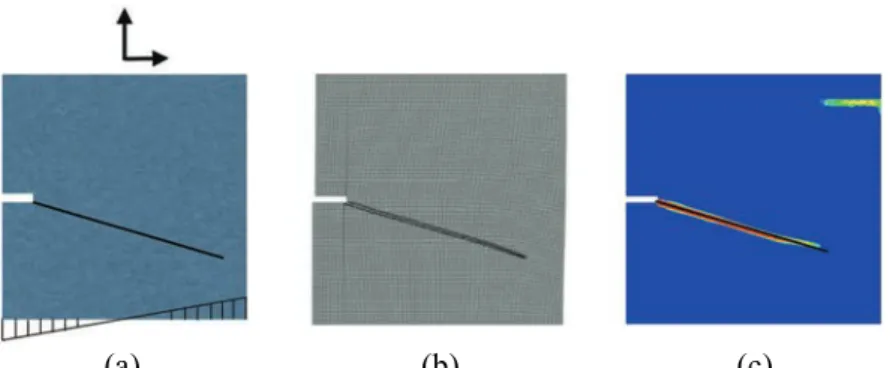HAL Id: hal-01706204
https://hal.archives-ouvertes.fr/hal-01706204
Submitted on 10 Feb 2018HAL is a multi-disciplinary open access archive for the deposit and dissemination of sci-entific research documents, whether they are pub-lished or not. The documents may come from teaching and research institutions in France or abroad, or from public or private research centers.
L’archive ouverte pluridisciplinaire HAL, est destinée au dépôt et à la diffusion de documents scientifiques de niveau recherche, publiés ou non, émanant des établissements d’enseignement et de recherche français ou étrangers, des laboratoires publics ou privés.
Public Domain
A virtual hybrid test to control mixed-mode crack
propagation in concrete
Andreea Carpiuc-Prisacari, Kyrylo Kazymyrenko, Martin Poncelet, Hugo
Leclerc, François Hild
To cite this version:
Andreea Carpiuc-Prisacari, Kyrylo Kazymyrenko, Martin Poncelet, Hugo Leclerc, François Hild. A virtual hybrid test to control mixed-mode crack propagation in concrete. 12e Colloque national en calcul des structures, CSMA, May 2015, Giens, France. �hal-01706204�
1
CSMA 2015
12 Colloque National en Calcul des Structures 18-22 Mai 2015, Presqu'île de Giens (Var)
A virtual hybrid test to control
mixed-mode crack propagation in concrete
A. Carpiuc-Prisacari1,2, K. Kazymyrenko1, M. Poncelet2, H. Leclerc2, F. Hild2 1
LaMSID (UMR EDF/CNRS/CEA 8193, EDF R&D),
carpiuc@lmt.ens-cachan.fr
,
kyrylo.kazymyrenko@edf.fr.
2
LMT-Cachan (ENS Cachan/CNRS/Université Paris 6/PRES UniverSud Paris),
poncelet@lmt.ens-cachan.fr
,
Hugo.LECLERC@lmt.ens-cachan.fr
,
hild@lmt.ens-cachan.
Résume: La minimisation du nombre d’essais nécessaires pour caractériser le comportement de matériaux reste encore un enjeu majeur. Le but de ce travail est de développer un test de fissuration de béton, riche et discriminant, capable de révéler l’ensemble du comportement mécanique en un seul essai. Un essai hybride de fissuration du béton piloté en facteur d’intensité des contraintes (FIC) est développé dans ce but. Préalablement au test réel, un test virtuel est conçu pour valider le principe de l'essai hybride proposé.
Abstract — The minimization of the number of experimental tests to characterize the material behavior continues to be an important challenge. The main aim of this work is to set up a relevant and discriminating concrete fracture test, able to fully investigate its complex mechanical behavior within a single run. Therefore a hybrid cracking test on a concrete sample with controlled stress intensity factors (SIFs) is currently developed. Prior to the real test, a virtual one is conceived to validate the principle of the proposed hybrid test.
Keywords — concrete fracture, damage, LEFM, hybrid tests.
1. Introduction
The concrete behavior under mixed-mode loading conditions, the crack initiation and propagation, the characterization of the process zone still represent a challenge both in the industrial and academic areas. Therefore the necessity of having relevant and discriminating damage and fracture models to accurately predict the crack paths and the force-displacement evolution for cement based materials.
The concrete microstructural heterogeneity is strongly reflected in the behavior of the material, presenting different crack formation mechanisms when subjected to different loading types. Having a different response when subjected to tensile, compression or shear loadings the elastic surface of concrete presents an important degree of complexity [1]. Therefore many of the existing non-linear numerical models used for structure simulations usually depend on a considerable number of parameters that have to be identified. Furthermore the choice between different models is rather non-trivial and has to be validated. The experimental mixed-mode crack propagation tests conducted on concrete specimens are rarely found in literature [2-3], because of the difficulty generated by the material heterogeneity and by the working scale, with a typical ratio of 105 between the sample’s dimensions and the applied displacements. Moreover in order to have the necessary amount of data to identify model’s parameters and/or to validate certain models an important number of tests have to be performed. The minimization of the tests number still represents an important challenge. In this aim a
hybrid cracking test is currently being developed. The hybrid test can be conceived to impose controlled stress intensity factors (SIFs) or to follow a desired crack path. The principle of these new, innovative tests is to establish a continuum communication between the experimental test and the numerical simulation, and by resolving an inverse problem, to determine in real time, by means of a numerical model, the boundary conditions required to obtain the desired crack path.
A first step towards a hybrid test is the development of a virtual hybrid test. The “real” cracking state is computed using a damage model [4], while the SIFs are obtained from a linear elastic fracture mechanics (LEFM) analysis. After each propagation step, the new data (the crack tip coordinates) is introduced in the LEFM model and the crack is reoriented by changing the loading conditions.
2. Virtual hybrid test principle
The hybrid tests are composed of three parts: (1) a numerical control used to recompute the BCs, (2) an experimental loading device (a hexapod) and (3) the measurement part, in which the crack tip is determined using Integrated Digital Image Correlation (I-DIC) [5]. The virtual hybrid tests respect the exact principle (Fig. 1): the numerical control is the same as used in the real test, the experimental loading device is replaced by a numerical simulation performed using a damage model in order to obtain a close to reality behavior and the assessment of the crack tip is also done by numerical means.
The virtual tests have an important contribution in the development and the optimization of the control technique, and also in the verification of the control’s accuracy. Another important aspect that can be approached by using a virtual hybrid test is the feasibility of different crack paths.
X-FEM
New BC computation
Virtual loading
Damage model
Replace the hexapod Virtual loading Damage model Replace the hexapod X-FEM New BC computation New BC computation New BC computation !"/!"" !"/!"" Crack tip Desired crack path Geometry update !=1 !s=1 !=1 !s=1 !"#$%&%'%()*+,(-%.*/0+12(,30#* ********************4=f(KI,KII) #/#s Crack tip Geometry update
Fig. 1 Virtual hybrid test principle
2.1. Numerical control
The numerical control is performed using LEFM. The crack propagation is governed by two concepts, one that prescribes the propagation threshold G ! GC and another one that defines the crack propagation direction, " = f(KI,KII). During this study the Maximum Normal Stress (MNS) criterion is used. A first challenge in characterizing the crack propagation with such a model consists in determining the SIFs for each loading step. Consequently the crack geometry has to be taken into account after each propagation increment. To accomplish this step the crack is defined using the
X-3
FEM framework [6-7]. The finite element model is enriched by adding degrees of freedom to the concerned elements, which take into account the displacement discontinuities through the crack surfaces and the stress field in the vicinity of the crack tip. In this study, computations are performed by coupling X-FEM with a level set propagation technique. One of the advantages of this approach is that the computations are carried out only using the sound mesh.
In addition to the determination of the SIFs values after each propagation step, a sensibility matrix has to be also computed. This sensibility matrix is the link between the stress intensity factors and the corresponding elementary displacements and is determined by applying a unitary traction displacement and a unitary shear displacement to the updated geometry.
2.2. Virtual solicitation
The damage model used to impose the virtual solicitation was developed by EDF R&D to characterize the crack propagation phenomena in certain quasi-brittle materials like concrete [4, 8]. It represents micro-cracking by a scalar field, which obeys the kinetics of an irreversible process. The elastic domain shape is set in order to differentiate compressive/tensile behaviors as it is necessary for concrete materials. Damage is represented by a scalar field a defined on the entire sample, a = 0 corresponding to sound material and a = 1 to totally damaged state. With the increase in damage the stiffness of the material, A(a), decreases (A(0) = 1 and, A(1) = 0).
The damage and the material stiffness changes are obtained using the following relation
Φ(ε, a) = A(a)Γ(ε) + ka +c 2(∇a
2
) (1)
where ε is the infinitesimal strain tensor, E the stiffness matrix, ka the dissipation energy, and c
the parameter that controls the size of the damage localization zone. Function Γ is expressed as Γ = αTr(ε) + βTr2(ε) +γ3 2ε dev: εdev " # $ % & ' 2 (2) where α,βand γ are numerical parameters that can be identified from three physical measurements, namely, the tensile strength, the compressive strength and the shear strength. The stress/strain relationship reads
σ = A(a)E : ε (3)
and the yield surface is obtained by deriving function Φ with respect to the damage variable a
f (ε, a) = −∂Φ
∂a (4)
and the consistency conditions read
f ≤ 0, a ≥ 0, af = 0 . (5)
3. First results
Several crack paths were tested using the virtual hybrid test. The results revealed that certain, like the one following a linear trajectory, do not present any particular difficulties (Fig. 2). On the contrary, when passing from a straight line to a more complex crack path, presenting a change of direction, the crack reorientation is not instantaneous because of the development of an important process zone (Fig. 3). The virtual loop also reveals that several crack paths were impossible to achieve.
(a) (b) (c)
Fig. 2 Virtual hybrid test results for an imposed straight crack path: (a) imposed cracked path, (b) X-FEM results, (c) damage model crack path confronted with the desired trajectory.
(a) (b) (c)
Fig. 3 Virtual hybrid test results for a more complex imposed crack path: (a) imposed cracked path, (b) X-FEM results, (c) damage model crack path confronted with the desired trajectory.
4. Conclusions
By coupling a LEFM model with a damage model a hybrid virtual test was developed. Considering the complexity of a real hybrid test, the use of such numerical simulations is very important to prepare, to anticipate difficulties that may arise during the real test. In perspective, in order to have a more accurate and a more reactive response, the numerical hybrid test will be improved and optimized.
Références
[1] S.K Lee, Y.C. Song, S.H Han, Biaxial behavior of plain concrete of nuclear containment building. Nuclear Engineering and Design 227: 143-155 (2004).
[2] M.B. Nooru-Mohamed, Mixed-mode fracture of concrete: an experimental approach. PhD thesis, Technische Universteit Delft (1992).
[3] B. Winkler, “Traglastuntersuchungen von unbewehrtenund bewehrten Betonstrukturen”. PhD thesis, University of Innsbruck (2001).
[4] E. Lorentz, S. Andrieux. A variational formulation for nonlocal damage models. Int. J. Plast. 15, pp. 119-138 (1999).
[5] S. Roux, J. Réthoré, F. Hild. Digital Image Correlation and Fracture: An Advanced Technique for Estimating Stress Intensity Factors of 2D and 3D Cracks. J. Phys. D: Appl. Phys., 42, 214004 (2009). [6] S. Geniaut, P. Massin, N. Moës, A stable 3D contact formulation for cracks using X-FEM, European
Journal of Computational Mechanics, Special Issue : New trends in the development of the X-FEM, Vol. 16, n°2, 2007.
[7] D. Colombo, An implicit geometrical approach to level sets update for 3D non planar X-FEM crack propagation. Comput. Meth. Appl. Mech. Eng. 237-240, p. 39-50 (2012).
[8] E. Lorentz, V. Godard. Gradient damage models: Toward full-scale computations. Comput. Meth. Appl.

